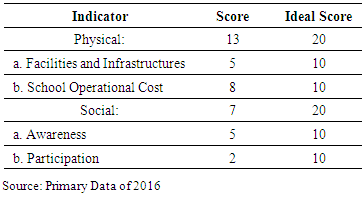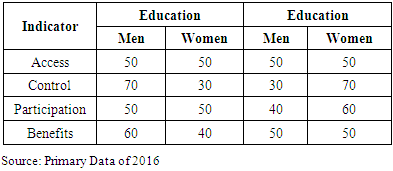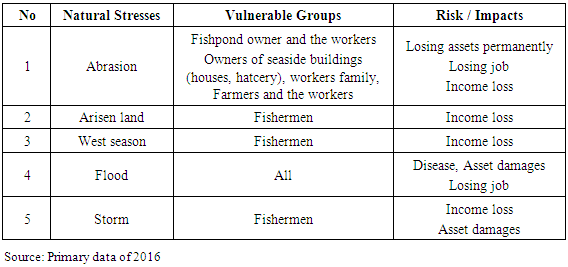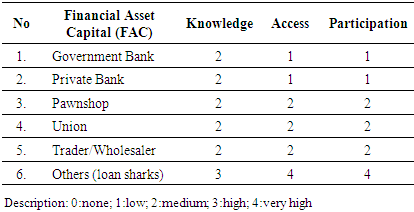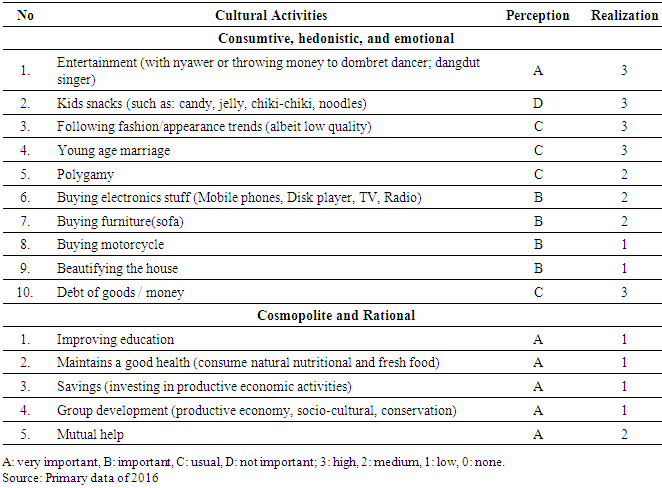-
Paper Information
- Paper Submission
-
Journal Information
- About This Journal
- Editorial Board
- Current Issue
- Archive
- Author Guidelines
- Contact Us
Resources and Environment
p-ISSN: 2163-2618 e-ISSN: 2163-2634
2017; 7(6): 176-185
doi:10.5923/j.re.20170706.04

Sustainable Livinghood Analysis (SLA) of Coastal Communities in Mangrove Forest Area in Pasuruan Regency East Java
Ibnu Sina1, Maryunani2, J. Batoro2, N. Harahab2
1Doctoral Program of Environmental Science, Brawijaya University, Malang, Indonesia
2Lecturer of Brawijaya University, Malang, Indonesia
Copyright © 2017 Scientific & Academic Publishing. All Rights Reserved.
This work is licensed under the Creative Commons Attribution International License (CC BY).
http://creativecommons.org/licenses/by/4.0/

Livelihood strategy is activity of directing or carefully planning to carefully responding to changes in life in order to obtain the desired target or goal. This research was conducted with the aim to know the pattern of community life in the coastal area of mangrove forest and analyze the relation of resources (financial, physical, social, human, and natural) to the sustainability of coastal community life in Pasuruan Regency. The method used in this research is quantitative descriptive method that describes a phenomenon of coastal areas. The focus on this research area is in Pasuruan Regency at mangrove forest area in Pulokerto Village of Kraton District with 22.5 ha coastal area, and socio-economic activity of people in coastal area of mangrove forest at Pulokerto Village is fish farming aquaculture, there are 24 ponds in coastal areas of mangrove forest in Pulokerto Village. The results showed that: (1) Human capital resources have medium category with value 17,72, (2) Natural capital resources have high category with value 35,20, (3) Social capital resources have a high category with a value of 37.65, (4) Financial capital resources have low category with value of 12,86 and (5) Physical capital resources have medium category with value 18,81. Ownership of the five livelihood assets of coastal communities in Pulokerto Village of Kraton District of Pasuruan Regency can affect the strategies used by all the people that live in the village. Every individual from the community in Pulokerto Village of Kraton District of Pasuruan Regency has different problems. So it also needs a different strategies to overcome them and realize prosperity.
Keywords: Sustainable Livinghood Analysis, SLA and Community Lifestyle
Cite this paper: Ibnu Sina, Maryunani, J. Batoro, N. Harahab, Sustainable Livinghood Analysis (SLA) of Coastal Communities in Mangrove Forest Area in Pasuruan Regency East Java, Resources and Environment, Vol. 7 No. 6, 2017, pp. 176-185. doi: 10.5923/j.re.20170706.04.
Article Outline
1. Introduction
- Basically, livelihood is a multidimensional concept that shows results and activities. The understanding of the word livelihood is always associated with the context, assets, institutions, processes and outputs in the livelihood system. Therefore, the concept of livelihood in a contemporary sense is not a standalone concept, but must be understood in a specific and contextual way in relation to other components of the livelihood system. (Rijanta, 2010). To facilitate an understanding of livelihood, Scoone (2001) created a framework of thought. That framework tries to relate to conditions, contexts, and trends such as policy settings, politics, history, agroecology and socio-economic conditions, affecting livelihood resources (natural capital, financial capital / economic, human capital, social capital, and others).The importance of sustainable development concept is in line with the views of R. Chambers and G. Conway (1992) through his work "Sustainable Rural Livelihoods: Practical Concepts for 21st Century" which describes the importance of doing sustainable livelihood approach to understand the dimensions of local livelihoods from vulnerable conditions into sustainable by developing the assets that they possesses and the dynamics contained therein to the transformational process. Each locality always has assets contained in it, this asset can be used as a starting point in the process of transformation individually and the community. This Chambers paper also inspired DFID (Department for International Development), which was then interested to develop practically and disseminate it. One way by creating a practical manual on Sustainable Livelihood Guidance Sheet. In that book is developed a framework of understanding sustainable livelihoods: how peoples’ vulnerable livelihood conditions can be transformed into sustainability. By assessing livelihood assets that are diagrammatically pentagons shaped implies that the assets are not only physical material forms, but also social, financial, natural and human assets, in this case humans and the environment are viewed holistically.The United Nations Development Program (UNDP) (2007) develops sustainable livelihood principles in which people are the center of development focus (people- centered), understanding the livelihoods overall (holistic), responding to livelihoods dynamics, optimizing the potential of the community (building on strengths), harmonizing macro and micro policies (macro-micro links), realizing sustainability. Sustainable livelihood framework is an operational framework that describes the linkages and relationships between components of livelihood. The use of the SL framework means applying a sustainable livelihood approach as perspective and guidance on understanding and planning for sustainable livelihoods. There are 5 (five) livelihoods strategies, describing the efforts made by the community in achieving adequate livelihoods (UNDP, 2007). This strategy deals with how communities manage livelihood assets that are available, respond to changes that occur and determine priorities to sustaining or improving livelihoods. Expected outputs from the implementation of sustainable livelihood strategies are (1) improved community income, (2) increased prosperity, (3) reduced vulnerability, (4) increased food security, and (5) sustainable uses of natural resources.This research was conducted in Pulokerto Village of Kraton District of Pasuruan Regency with some reasons, including: (1) Pasuruan Regency has tremendous potential in the coastal sector. This area has long coastline and good soil quality for mangrove forest. Therefore, Pasuruan Regency was chosen as the location of Mangrove Study Center. The world's first study center was built by the Marine and Fisheries Human Resources Development Agency (Badan Pengembangan SDM Kelautan dan Perikanan, BPSDM KP) of the Ministry of Marine Affairs and Fisheries, (2) Pasuruan Regency is the location of the implementation of Blue Economy concept integrated into fishery cultivation and environmental conservation by utilizing mangrove as biofilter and (3) On Pasuruan Regency, precisely located in the coastal area of mangrove forest in Pulokerto Village of Kraton District has a coastal area of 22.5 ha and has 24 plot ponds in which it is used for aquaculture with monoculture system, polyculture and silvofisheries. Cultivated commodities include milkfish, tiger shrimp, white snapper, soka crab and seaweed. The details of its utilization are: 7 cultivation plot points are selected including plots 12 Progressive Milkfish Cultivation, Plot 16 Polyculture Seaweed and Milkfish, Plot 24 Polyculture Tiger Shrimp and Milkfish with Silvofisheries system, Plot 3 Polyculture Crab and White Snapper.Map of research location in Pulokerto Village of Kraton District of Pasuruan Regency, East Java can be seen below.
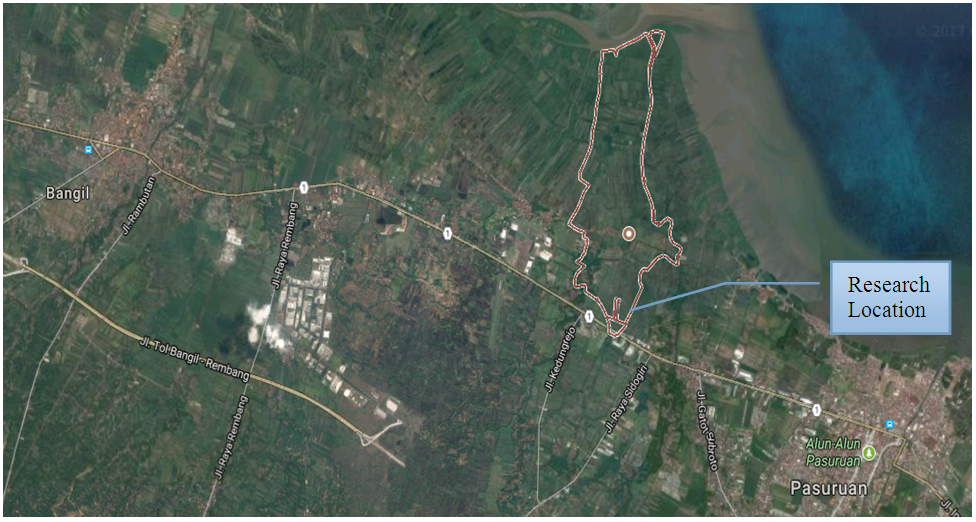 | Figure 1. Research Location Map |
2. Research Methods
- The method used in this research is quantitative descriptive method that describes a phenomenon in coastal areas. The focus on this research area is in Pasuruan in mangrove forest area in Pulokerto Village of Kraton District that has coastal area of 22.5 ha, and socio-economic activity of people in coastal area of mangrove forest of Pulokerto Village is fishery aquaculture pond, that has 24 fish farming ponds in coastal areas of mangrove forest in the Pulokerto Village.The sustainable livelihood approach (SLA) takes a holistic perspective in determining the problems and opportunities of a program activity. This holistic perspective takes into account the following:a. Contextual. This approach analyzes whether an economic, social, or demographic that influences the livelihood options of a particular population and what risks it may face.b. Resource. This SLA approach analyzes the resources (financial, physical, social, human and natural) that are owned by or accessible to households and communities and how these resources are sorted out.c. Institutions and organizations. Institutions operating in certain contexts are crucial to determining the sustainability of a livelihood.d. Livelihoods strategy. Holistic diagnosis tries to identify strategies used by a person or household or community group to earn a living and how they cope with the pressures.e. Livelihood results. These results are measured to determine how households are successful in implementing their livelihood strategies. These results can be based on normative standards (eg nutritional status) or criteria identified by the community.The Sustainable Livelihoods Approach (SLA) is a method of analyzing and changing the lives of people that experience poverty and economy weakness. This approach is participatory and based on the confession that everyone has the capabilities and assets that can be developed to help him improve his livelihood.
3. Empirical Results
- Individuals have a behave tendency to sustain life with strategies that influenced by asset control. (Scoone, 1998; DFID, 1999). Asset control includes assets in the form of Human Capital, Natural Capital, Social Capital, Physical Capital and Financial Capital.
3.1. Human Capital
- Two main points that considered to determine the condition of human assets capital are education and health. The level of education as an indicator of human assets capital seen from the number of people aged above 17 years who successfully reached the standard education in 2012, which is 9 year compulsory education (finished junior high school) or more in Pulokerto which is 38.03%. Data on the availability of educational facilities and infrastructures, education operational costs, awareness of the importance of education and participation as physical and social indicators for the implementation of compulsory education in the study sites can be mapped in the following table.
|
|
|
3.2. Natural Resources Capital
- Utilization of marine resources mostly in the form of fish by catch fishermen. Another use is to use kale for the consumption of vegetable food, grasses for animal feed. As for a small portion that is land ownership and utilize for agriculture and garden for horticultural crops. General Asset Capital / NAC assessment results obtained from observation and Focus Group Discussions (FGDs) involving local communities in a participatory way in Pulokerto Village of Kraton District of Pasuruan Regency can be mapped in the table below.
|
|
|
3.3. Financial Resources
- The results of this study explain that Financial Assets Capital / FAC in Pulokerto Village of Kraton District of Pasuruan Regency include knowledge, access and public participation to financial institutions that can be seen in the table below.
|
3.4. Social Resources Capital
- The description of social capital resources or Social Asset Capital in Pulokerto Village, Kraton District, Pasuruan Regency overall can be summarized as having characteristics of rural community in general, among others: (1). The relationship between citizens has a deep and close relationship when compared with the community outside its borders, (2). Life systems are generally clustered on the basis of kinship (Gemeinscharft or paguyuban), (3). Some villagers live from capture fisheries, freshwater fish farming and non-marine / coastal jobs are part time jobs as leisure and (4). Villagers are relatively homogeneous as in livelihood, religion, customs and others.Social Asset Capital / SAC in Pulokerto Village, Kraton District, Pasuruan Regency was built and maintained through limited social relationships in small groups such as neighborhood units (Rukun Tetangga, RT), grief support group (Rukun Kematian, RK), social gathering, recitation group, neighborhood security patrol (siskamling) and so forth. However, the SAC maintained by religious and customary norms in Pulokerto Village of Kraton District of Pasuruan Regency is not entirely conducive to poverty eradication efforts. The various consumptive and hedonistic behaviors they bring up from generation to generation instead of helping to helping the poor but instead bringing them to a deteriorating and poverty. Various activities of the village community as Social Asset Capital / SAC in Pulokerto Village of Kraton District of Pasuruan Regency have the tendency between emotional consumptive hedonistic and rational cosmopolite. Further related to the cultural activities of the community can be explained in the table 8.
|
3.5. Physical Resources
- Physical capital resources are one indicator that a society in a region has reached prosperity. Observations with interviewees related to Physical Assets Capital / PAC ownership for the community have different qualifications so that the measurement is done qualitatively. The identification results related to physical resources or Physical Assets Capital / PAC of the community in coastal areas in Pulokerto Village of Kraton District of Pasuruan Regency can be seen in the table 9.
|
3.6. Pentagon Assets
- The results of this study explains that the condition of livelihood assets for the community in Pulokerto Village of Kraton District of Pasuruan Regency either human capital, natural capital, social capital, financial capital, and physical capital as follows: (a). Human capital resources have medium category with value of 17,72, (b). Natural capital resources have high category with value of 35,20, (c). Social capital resources have a high category with a value of 37.65, (d). Financial capital resources have low category with value of 12,86 and (e). Physical capital resources have medium category with value of 18,81. The results of this study relate to the ownership of the five livelihood assets of coastal communities in Pulokerto Village of Kraton District can be seen in the picture 3.
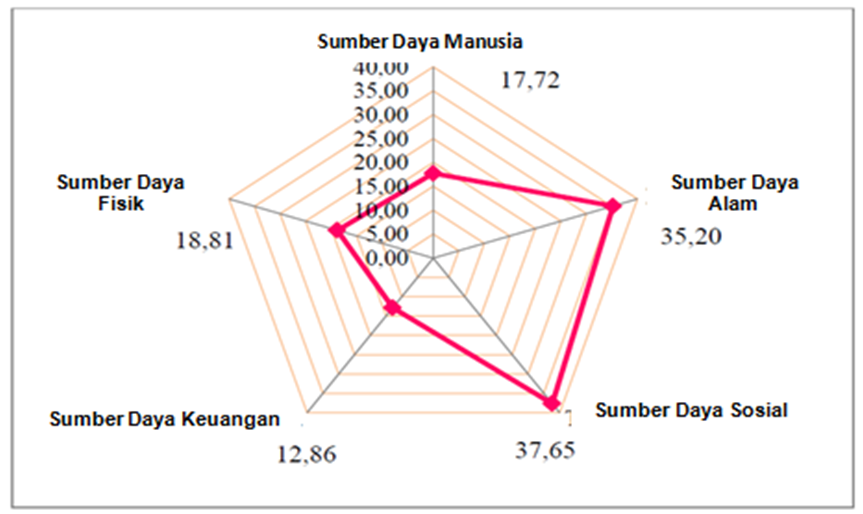 | Figure 2. Pentagon Analysis Results on Coastal Communities Resources in Pulokerto Village, Kraton District, Pasuruan Regency |
3.7. Sustained Intervention of Coastal Communities
- The results of this study explain that the condition of livelihood assets for the community in Pulokerto Village of Kraton District of Pasuruan Regency either human capital, natural capital, social capital, financial capital, and physical capital should be intervened with different approaches so that will be realized the life of coastal communities that sustainable (sustainable livelihood). The scheme of the intervention of ownership of five livelihood assets from coastal communities in Pulokerto Village, Kraton District, Pasuruan Regency to overcome that and realize welfare can be seen on illustration as follows:
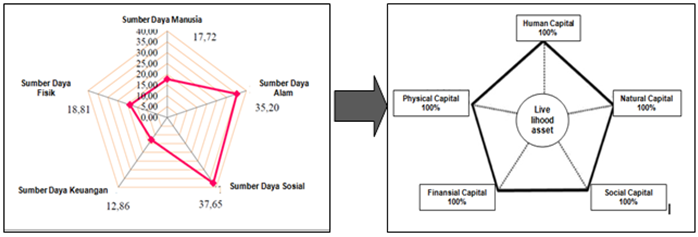 The form of intervention to the condition of livelihood assets for the community in the Pulokerto Village of Kraton District of Pasuruan Regency as follows: 1. Human capital resource with value of 17,72Interventions that need to be done in relation to the human capital resources are as follows: (a) Interventions that encourage employment training and coastal community-based empowerment programs based on non-mangrove forests and marine resources both capture and cultivation, (b) Interventions that can support the participation or involvement of fishing groups in coastal areas, (c) Accelerate achievement of program targets and implementation of coastal area development planning strategies that can support increased production of marine resource commodities followed by increased accessibility of public facilities. 2. Natural capital resources with a value of 35.20Interventions that need to be done in relation to the natural resources are as follows: (a) The initialization to the model of the Community-Based Marine Protected Area (Daerah Perlindungan Laut Berbasis Masyarakat, DPL-BM) including the Mangrove Protection Area (Daerah Perlindungan Mangrove, DPM) that is selected coastal and marine area and determine to be permanently closed from fisheries and resource extraction activities, and managed by local communities, (b) Improving coastal environmental sustainability programs aimed at members of the neighborhood unit (RT) of fishing village so to restore the damaged coastal environment that further affects the welfare of fishermen, and (c) Synchronize between coastal development program and policies to conserve nature and environment independently in coastal communities. 3. Social capital resources with a value of 37.65Interventions that need to be done in relation to the social resources are as follows: (a) Increasing the quantity and quality of the implementation of social capital among coastal communities so as to manage coastal natural resources as a capital to mobilize the development of area by welfare-oriented development, (b) Carry out awareness programs and rescue socio-cultural values in coastal areas through education, religious and social activities in coastal communities, (c). Encourage the implementation of social capital utilization in the form of fisherman network to be able to suppress production and marketing cost of fishing and cultivation based business, (d) Social capital is directed to develop the internal capacity of coastal communities to be able to define their needs and to discuss alternative fulfillment using existing potentials, (e) Improved leadership capacity of community leaders to be able to guide the community to exploit the potential of coastal natural resources exist maximally. 4. Financial capital resources with a value of 12.86Interventions that need to be done in relation to the financial resources are as follows: (a) Synchronizing the partnership program with the private sector by the development of soft loan facilities in the coastal areas to support increased production of catch and aquaculture natural resources, (b) Increasing accessibility of public infrastructure, particularly banking and transportation modes for coastal community with concrete policies that can reduce the production cost of marketing of catch fish and cultivated fish, (c). Provide assistance in the submission and use of loan by coastal communities with the aim to maintain the use of loans according to purpose of loans which is the optimization of sustainable coastal resource management, (d) Encourage the development of Micro, Small, or Medium Enterprises (Usaha Mikro, Kecil, dan Menengah, UMKM) through the development of clusters based on marine fish and cultivated fish. The establishment of UMKM through the cluster model integrated from upstream to downstream so that coastal communities will benefit from cooperation with medium enterprises and large enterprises that act as local champions in a similar business community. 5. Physical capital resources with a value of 18.81Interventions that need to be done in relation to the physical resources are as follows: (a) Interventions on the provision of infrastructure and facilities related to telecommunication networks to facilitate coastal communities to obtain information so as to encourage sustainable coastal resource management capabilities, (b) Constructing the Sustainable Economic Reengineering model based on Union through empowering Coastal Community Resources, (c) Encourage the variety of work done by coastal community families by involving the role of wives in supporting the household economy, (d) Familiarize to save or make investment in coastal communities because the fishery field tends to contain a greater risk than other agricultural sectors and (e) Encourage the establishment of small industries in the village so as to increase the role and contribution of women to provide for their households.
The form of intervention to the condition of livelihood assets for the community in the Pulokerto Village of Kraton District of Pasuruan Regency as follows: 1. Human capital resource with value of 17,72Interventions that need to be done in relation to the human capital resources are as follows: (a) Interventions that encourage employment training and coastal community-based empowerment programs based on non-mangrove forests and marine resources both capture and cultivation, (b) Interventions that can support the participation or involvement of fishing groups in coastal areas, (c) Accelerate achievement of program targets and implementation of coastal area development planning strategies that can support increased production of marine resource commodities followed by increased accessibility of public facilities. 2. Natural capital resources with a value of 35.20Interventions that need to be done in relation to the natural resources are as follows: (a) The initialization to the model of the Community-Based Marine Protected Area (Daerah Perlindungan Laut Berbasis Masyarakat, DPL-BM) including the Mangrove Protection Area (Daerah Perlindungan Mangrove, DPM) that is selected coastal and marine area and determine to be permanently closed from fisheries and resource extraction activities, and managed by local communities, (b) Improving coastal environmental sustainability programs aimed at members of the neighborhood unit (RT) of fishing village so to restore the damaged coastal environment that further affects the welfare of fishermen, and (c) Synchronize between coastal development program and policies to conserve nature and environment independently in coastal communities. 3. Social capital resources with a value of 37.65Interventions that need to be done in relation to the social resources are as follows: (a) Increasing the quantity and quality of the implementation of social capital among coastal communities so as to manage coastal natural resources as a capital to mobilize the development of area by welfare-oriented development, (b) Carry out awareness programs and rescue socio-cultural values in coastal areas through education, religious and social activities in coastal communities, (c). Encourage the implementation of social capital utilization in the form of fisherman network to be able to suppress production and marketing cost of fishing and cultivation based business, (d) Social capital is directed to develop the internal capacity of coastal communities to be able to define their needs and to discuss alternative fulfillment using existing potentials, (e) Improved leadership capacity of community leaders to be able to guide the community to exploit the potential of coastal natural resources exist maximally. 4. Financial capital resources with a value of 12.86Interventions that need to be done in relation to the financial resources are as follows: (a) Synchronizing the partnership program with the private sector by the development of soft loan facilities in the coastal areas to support increased production of catch and aquaculture natural resources, (b) Increasing accessibility of public infrastructure, particularly banking and transportation modes for coastal community with concrete policies that can reduce the production cost of marketing of catch fish and cultivated fish, (c). Provide assistance in the submission and use of loan by coastal communities with the aim to maintain the use of loans according to purpose of loans which is the optimization of sustainable coastal resource management, (d) Encourage the development of Micro, Small, or Medium Enterprises (Usaha Mikro, Kecil, dan Menengah, UMKM) through the development of clusters based on marine fish and cultivated fish. The establishment of UMKM through the cluster model integrated from upstream to downstream so that coastal communities will benefit from cooperation with medium enterprises and large enterprises that act as local champions in a similar business community. 5. Physical capital resources with a value of 18.81Interventions that need to be done in relation to the physical resources are as follows: (a) Interventions on the provision of infrastructure and facilities related to telecommunication networks to facilitate coastal communities to obtain information so as to encourage sustainable coastal resource management capabilities, (b) Constructing the Sustainable Economic Reengineering model based on Union through empowering Coastal Community Resources, (c) Encourage the variety of work done by coastal community families by involving the role of wives in supporting the household economy, (d) Familiarize to save or make investment in coastal communities because the fishery field tends to contain a greater risk than other agricultural sectors and (e) Encourage the establishment of small industries in the village so as to increase the role and contribution of women to provide for their households. 4. Conclusions
- This research was conducted with the aim to know the pattern of community life in the coastal area of mangrove forest and analyze the relation of resources (financial, physical, social, human and natural) to the sustainability of coastal community life in Pasuruan Regency. As for the study results yielded some conclusions, including as follows: (1) The condition of livelihood assets for the community in Pulokerto Village, Kraton District, Pasuruan Regency, includes human capital, natural capital, social capital, financial capital, and physical capital has various categories. The results of this study explain that the condition of livelihood assets for the community in Pulokerto Village, Kraton District, Pasuruan Regency including human capital, natural capital, social capital, financial capital, and physical capital as follows: (a). Human capital resources in Pulokerto Village of Kraton District of Pasuruan Regency have medium category with value of 17,72, (b) Natural capital resources in Pulokerto Village of Kraton District of Pasuruan Regency has high category with value of 35,20, (c) Social capital resources in Pulokerto Village of Kraton District of Pasuruan Regency has high category with value of 37,65, (d) The financial capital resources in Pulokerto Village of Kraton District of Pasuruan Regency have low category with value of 12,86 and (e) Physical capital resources in Pulokerto Village of Kraton District of Pasuruan Regency has medium category with value of 18,81 and (2). Adaptation options undertaken by communities in the coastal areas of Pulokerto Village of Kraton District of Pasuruan Regency, are: (1). diversify sources of income, (2). utilizing social relations, (3). mobilize household members, and (4). do diversification of fishing gear, relying on the help of various parties.
 Abstract
Abstract Reference
Reference Full-Text PDF
Full-Text PDF Full-text HTML
Full-text HTML
